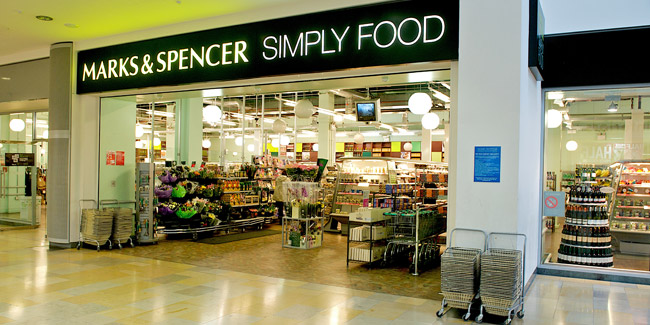
British retail giant Marks and Spencer (M&S) just recently announced their plans to slash stores and realign their focus to the food division. Founded in the late 1800s, M&S is traditionally known for their posh clothing and luxurious home products, so why are they now concentrating more on food? Is phasing out of their traditional base the right move? Notably, these changes come months after the installation of a new CEO as well as a long period of declining sales.[1]
CEO Steve Rowe believes that shifting towards the food industry is extremely profitable because of the increasing trend in online shopping[2]. M&S will be able to devote more floor space to food, a department that has proven to be more profitable, without entirely neglecting sales from fashion, thereby adjusting to customer demands.

M&S Simply Food
Declining sales are mostly attributed to lower priced competitors like Uniqlo and Zara, a failure to realize their customer segments, and failed investments on overseas franchises[3[. Upon further analysis, I discovered that many of their inherent problems are correlated with the concepts discussed in class. Rowe said the company incorrectly focused on younger shoppers while they forgot about their most loyal segment, middle-aged women. Moving on, Rowe has pledged that he will “cherish and listen” to this segment. Additionally, the cost of shutting down overseas franchises will be an additional 200 million pounds[4]; although a sunk cost, these cuts will allow for M&S to regroup and adjust accordingly.
Alena Goncharova‘s blog post mentions all the steps that M&S is taking to survive in the retail industry. It highlights the need to gain a competitive advantage, the importance of e-commerce, and the ability to adapt and modify a company’s business model canvas. I completely agree with her opinion and believe that M&S is on the right path by making similar adjustments.
A Porter’s 5 forces of industry attractiveness[5] shows that the fashion industry is unappealing. As e-commerce becomes more popularized, there will be little to no need for actual clothing stores. Sure, trying something out in a fitting room may be appealing, but expedited shipping and returns allow for that to happen at the convenience of your own home. Buyers are becoming increasingly powerful with unlimited choices as new competitors enter the sector day in and day out. With certainty, the industry is highly unattractive and in rapid decline.
In order to survive in the dying fashion trade[6], M&S is differentiating themselves by adjusting to customer demand and shifting to food . In my opinion, M&S is making the right move to focus on something that has proven to be more profitable. These changes may hurt them in the short-run, but they are inevitable to survive in the long-run.
Word Count (450)
Citations:
[1] “M&S Retreats from Foreign Markets in Store Shakeup.” Financial Times. N.p., n.d. Web. 12 Nov. 2016.
[2,3] Wood, Zoe. “M&S to Close 30 UK Stores and Cut Back on Clothing.” The Guardian. Guardian News and Media, 2016. Web. 12 Nov. 2016.
[4] “Marks and Spencer Plans Store Closures after Profit Drops.” Wall Street Journal. N.p., n.d. Web. 12 Nov. 2016.
[5] “Porter’s Five Forces.” Porter’s Five Forces. N.p., n.d. Web. 12 Nov. 2016.
[6] Murdock, Sharifa. “4 Reasons The Retail Industry Is Declining.” The Huffington Post. TheHuffingtonPost.com, n.d. Web. 12 Nov. 2016.